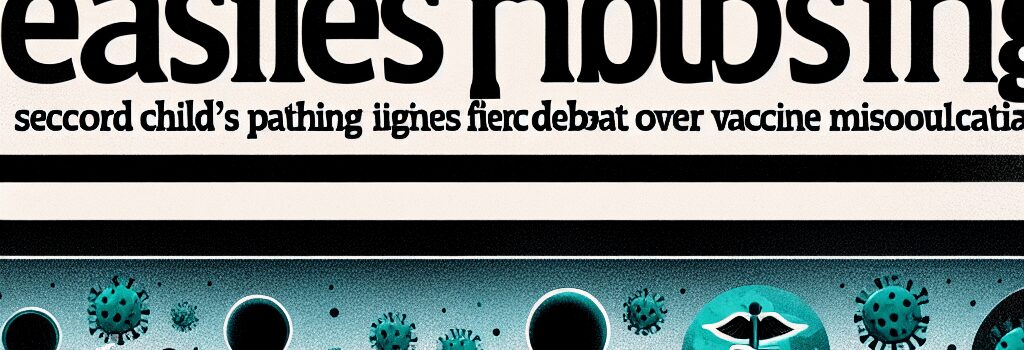Child’s Death During Measles Outbreak Sparks Vaccine Debate

A second unvaccinated child has succumbed to measles complications in Texas, intensifying an already raging outbreak and sparking a broader debate about the dangers of vaccine misinformation. The latest victim, an 8-year-old identified as Daisy Hildebrand by US Health Secretary Robert F. Kennedy Jr., was being treated at UMC Health System in Lubbock. According to the hospital’s statement, Daisy, who had no underlying health conditions, died from what doctors have confirmed as measles pulmonary failure.
Outbreak Overview and Epidemiological Data
State health officials report that this recent death is only the third in a measles outbreak that began in late January in undervaccinated counties across Western Texas. The statistics are concerning:
- At least 569 measles cases have been identified as of April 4.
- 58 hospitalizations have been recorded, with Texas contributing 481 cases and 56 hospitalizations.
- Other states in the region include New Mexico with 54 cases (2 hospitalizations), Kansas with 24 cases, and Oklahoma with 10 cases.
While the Centers for Disease Control and Prevention (CDC) estimates that 1 to 3 in every 1,000 children infected with measles may die from complications, experts worry that unreported cases, delayed medical care, and reliance on unproven treatments could be obscuring the true scale of the outbreak.
Technical Analysis of Misinformation and Data Management
The handling of outbreak data and subsequent reporting has become a focal point. In this instance, anti-vaccine spokesperson Robert Malone preemptively disseminated misinformation regarding the cause of death by disputing the measles diagnosis. Malone’s assertions, including his unverified review of medical records, stand in stark contrast to findings published in reputable outlets such as The New York Times and the official UMC statement.
From a technical standpoint, the rapid propagation of unverified data highlights the crucial role of digital epidemiological analytics. Modern public health relies on robust data pipelines, secure health information exchanges, and real-time reporting systems to mitigate the spread of misinformation. Advanced data visualization and cross-referencing platforms used by the CDC and state health departments are key tools in ensuring that accurate information reaches the public promptly.
Digital Misinformation Amplification on Social Media
The delay between official reporting and early, unverified claims on social media platforms underscores a broader trend: the amplification of vaccine misinformation online. Anti-vaccine influencers, emboldened by figures like Robert F. Kennedy Jr., have leveraged social media to promote non-evidence-based treatments such as vitamin A supplementation, cod liver oil, and misapplied doses of glucocorticoids like budesonide.
Two practitioners, Ben Edwards and Richard Bartlett, have received significant attention in West Texas from vaccine-hesitant communities. Edwards, who previously treated siblings in a similar outbreak scenario, and Bartlett, who faced disciplinary action in 2003 for his unsafe practices, continue to shape public perception through digital channels. The rapid spread of their messages is facilitated by algorithm-driven content discovery, which often bypasses traditional fact-checking processes.
Expert Opinions on Data Reliability and Public Health Response
Health experts emphasize that robust data integrity remains critical during health emergencies. Dr. Elena Martinez, an epidemiologist with expertise in outbreak surveillance, noted that “public trust in health data systems is paramount. When misinformation infiltrates these systems, it not only endangers lives but also undermines the overall public health response.”
Experts highlight that modern health systems can use cloud computing and machine learning algorithms to detect anomalies in outbreak data. These systems, already integral to the CDC’s operations, can flag suspicious patterns that may indicate misinformation or data tampering. Such advanced analytics offer a layer of assurance to both policymakers and the public when navigating the digital information landscape.
Looking Ahead: Strengthening Public Health Infrastructure and Digital Communication
This case serves as a stark reminder of the need for cohesive communication strategies in times of crisis. Public health authorities are now urged to bolster their digital outreach platforms and leverage cybersecurity measures to protect sensitive health data from misinformation campaigns. Improved coordination between local hospitals, state departments, and national bodies such as the CDC is crucial for both rapid response and long-term public health planning.
In conclusion, while modern data analytics and digital communication tools offer unprecedented capabilities for outbreak detection and management, the ongoing measles outbreak in Texas illustrates the persistent challenges posed by misinformation. As health systems continue to integrate advanced technologies, the dual goals of data integrity and clear, factual communication remain more critical than ever.